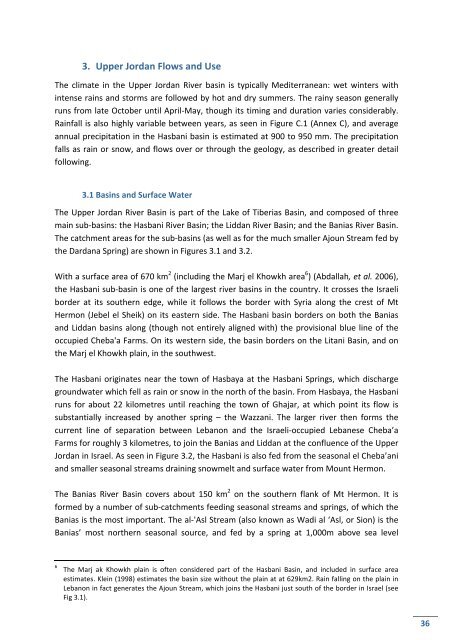Hydro-‐political Baseline of the Upper Jordan River - Ibrahim Abd El Al
Hydro-‐political Baseline of the Upper Jordan River - Ibrahim Abd El Al
Hydro-‐political Baseline of the Upper Jordan River - Ibrahim Abd El Al
Create successful ePaper yourself
Turn your PDF publications into a flip-book with our unique Google optimized e-Paper software.
3. <strong>Upper</strong> <strong>Jordan</strong> Flows and Use<br />
The climate in <strong>the</strong> <strong>Upper</strong> <strong>Jordan</strong> <strong>River</strong> basin is typically Mediterranean: wet winters with<br />
intense rains and storms are followed by hot and dry summers. The rainy season generally<br />
runs from late October until April-‐May, though its timing and duration varies considerably.<br />
Rainfall is also highly variable between years, as seen in Figure C.1 (Annex C), and average<br />
annual precipitation in <strong>the</strong> Hasbani basin is estimated at 900 to 950 mm. The precipitation<br />
falls as rain or snow, and flows over or through <strong>the</strong> geology, as described in greater detail<br />
following.<br />
3.1 Basins and Surface Water<br />
The <strong>Upper</strong> <strong>Jordan</strong> <strong>River</strong> Basin is part <strong>of</strong> <strong>the</strong> Lake <strong>of</strong> Tiberias Basin, and composed <strong>of</strong> three<br />
main sub-‐basins: <strong>the</strong> Hasbani <strong>River</strong> Basin; <strong>the</strong> Liddan <strong>River</strong> Basin; and <strong>the</strong> Banias <strong>River</strong> Basin.<br />
The catchment areas for <strong>the</strong> sub-‐basins (as well as for <strong>the</strong> much smaller Ajoun Stream fed by<br />
<strong>the</strong> Dardana Spring) are shown in Figures 3.1 and 3.2.<br />
With a surface area <strong>of</strong> 670 km 2 (including <strong>the</strong> Marj el Khowkh area 6 ) (<strong>Abd</strong>allah, et al. 2006),<br />
<strong>the</strong> Hasbani sub-‐basin is one <strong>of</strong> <strong>the</strong> largest river basins in <strong>the</strong> country. It crosses <strong>the</strong> Israeli<br />
border at its sou<strong>the</strong>rn edge, while it follows <strong>the</strong> border with Syria along <strong>the</strong> crest <strong>of</strong> Mt<br />
Hermon (Jebel el Sheik) on its eastern side. The Hasbani basin borders on both <strong>the</strong> Banias<br />
and Liddan basins along (though not entirely aligned with) <strong>the</strong> provisional blue line <strong>of</strong> <strong>the</strong><br />
occupied Cheba'a Farms. On its western side, <strong>the</strong> basin borders on <strong>the</strong> Litani Basin, and on<br />
<strong>the</strong> Marj el Khowkh plain, in <strong>the</strong> southwest.<br />
The Hasbani originates near <strong>the</strong> town <strong>of</strong> Hasbaya at <strong>the</strong> Hasbani Springs, which discharge<br />
groundwater which fell as rain or snow in <strong>the</strong> north <strong>of</strong> <strong>the</strong> basin. From Hasbaya, <strong>the</strong> Hasbani<br />
runs for about 22 kilometres until reaching <strong>the</strong> town <strong>of</strong> Ghajar, at which point its flow is<br />
substantially increased by ano<strong>the</strong>r spring – <strong>the</strong> Wazzani. The larger river <strong>the</strong>n forms <strong>the</strong><br />
current line <strong>of</strong> separation between Lebanon and <strong>the</strong> Israeli-‐occupied Lebanese Cheba’a<br />
Farms for roughly 3 kilometres, to join <strong>the</strong> Banias and Liddan at <strong>the</strong> confluence <strong>of</strong> <strong>the</strong> <strong>Upper</strong><br />
<strong>Jordan</strong> in Israel. As seen in Figure 3.2, <strong>the</strong> Hasbani is also fed from <strong>the</strong> seasonal el Cheba’ani<br />
and smaller seasonal streams draining snowmelt and surface water from Mount Hermon.<br />
The Banias <strong>River</strong> Basin covers about 150 km 2 on <strong>the</strong> sou<strong>the</strong>rn flank <strong>of</strong> Mt Hermon. It is<br />
formed by a number <strong>of</strong> sub-‐catchments feeding seasonal streams and springs, <strong>of</strong> which <strong>the</strong><br />
Banias is <strong>the</strong> most important. The al-‐'Asl Stream (also known as Wadi al ‘Asl, or Sion) is <strong>the</strong><br />
Banias’ most nor<strong>the</strong>rn seasonal source, and fed by a spring at 1,000m above sea level<br />
6 The Marj ak Khowkh plain is <strong>of</strong>ten considered part <strong>of</strong> <strong>the</strong> Hasbani Basin, and included in surface area<br />
estimates. Klein (1998) estimates <strong>the</strong> basin size without <strong>the</strong> plain at at 629km2. Rain falling on <strong>the</strong> plain in<br />
Lebanon in fact generates <strong>the</strong> Ajoun Stream, which joins <strong>the</strong> Hasbani just south <strong>of</strong> <strong>the</strong> border in Israel (see<br />
Fig 3.1).<br />
36


